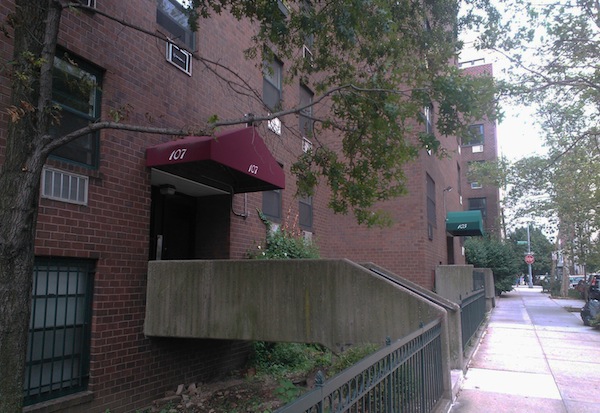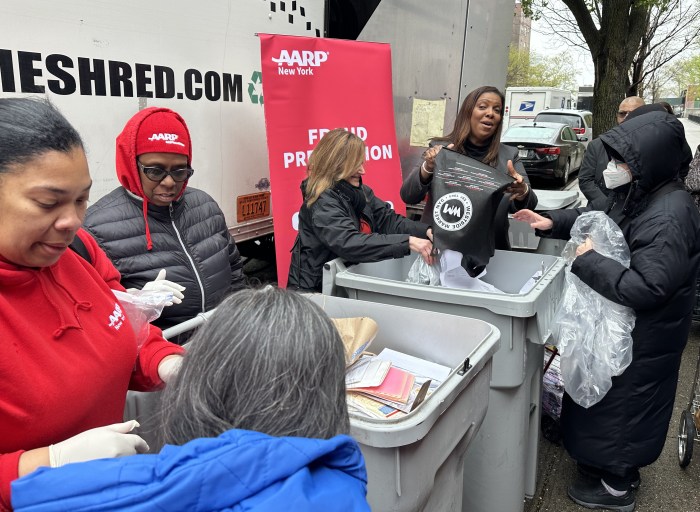
BY CLARISSA-JAN LIM | Tenants at the West Village Houses who don’t own their apartments could very well find themselves homeless five years from now. That’s when their rent stabilization is slated to end, and their rents could quadruple.
A product of the Village’s development battles of the 1960s, the West Village Houses include 42, low-rise buildings, bounded by Washington St. on the east, Morton St. on the south, West St. on the west, and Bank St. on the north. Jane Jacobs and her allies — after defeating Robert Moses’ plan to replace a swath of 14 blocks of old warehouses with towers — created the utilitarian-designed West Village Houses, which opened in 1974.
Although born in idealism, three decades later, the complex was feeling the stress of economic pressures. In 2006, the West Village Houses’ owners, as part of their plan to take the 420-unit complex out of the Mitchell Lama program, initially sought to hike rents by 300 percent, which few of the tenants could afford. The median income of the complex’s tenants then was $65,000.
Instead, in a historic agreement, the owners converted the development into an affordable noneviction co-op. They allowed the existing tenants to buy their units at a discounted rate.
In addition, those who chose to continue renting were allowed to do so. However, the deal for them wasn’t open-ended. The remaining renters — today comprising about 70 apartments, or one-sixth of the total units — now face a looming deadline of April 2018, by when they’ll have to start paying likely significantly higher rents or move out of the homes and neighborhood that they helped build.
Before the 2006 agreement was finalized, there were discussions of having the co-op commit to establishing a subsidy fund to protect low-income residents who did not buy their apartments from overwhelming rent increases. At the time, Katy Bordonaro, then W.V.H. Tenants Association president, estimated that for the next dozen years at least, rent increases would be close to the city’s annual guidelines for rent-stabilized tenants. But there were no assurances beyond 2018 — and, in fact, the final deal did not require the establishment of a subsidy fund.
Speaking last week, James Lister, a member of the West Village Houses Renters Union, said that, seven years ago, the complex’s residents were primarily focused on ensuring that it remained affordable after it was taken out of the Mitchell Lama program. As a result, when the conversion plan was presented to tenants, it was, above all, touted as a noneviction plan. Lost in the excitement was the fact that, for those who chose not to buy their units, their rent stabilization would only last 12 years.
“The noneviction part was emphasized,” Lister said, “because that’s what we were all working for, that was supposed to be the point of the whole process, and decades of work so that we could all stay. ‘Noneviction’ to me means I decide when I leave, not tick-tick-tick — you’ve got 12 years. There was a sort of conflict there, but then the first few years it didn’t really matter because we were just paying our rent. It was probably three years or so before we actually got on the stick about what’s happening, and then we were like, ‘Wait a minute this isn’t a noneviction, this is a delayed eviction.’ ”
Most of the remaining renters at W.V.H. cannot afford to pay market rate for their apartments, said Constance Rodgers, who is one of them. She sent an open letter highlighting their plight to City Council Speaker Christine Quinn, and also forwarded it to The Villager.
Describing the renters, she said many of them are “middle class: teachers, firefighters, nurses, police, laborers and artists,” and have lived in West Village Houses for decades.
Quinn was instrumental in the agreement that led to the complex’s conversion into an affordable co-op. For the past four years, the Renters Union has been in consultation with her office to address the matter of their future.
“The intricacies of West Village Houses is well known to [Quinn’s office],” said Jessica Tomb, who was president of the Renters Union for six years before she recently purchased her apartment.
The Renters Union was established shortly before the co-op conversion in 2006, and assists the 70-odd W.V.H. renters in handling various affairs. Tomb said the issue of the 12-year expiration date is complex and ongoing, one that needs a creative solution that satisfies all parties involved — the renters, landlord and Quinn, who represents the district.
“It’s not a ‘one size fits all,’” Tomb said. “We have very elderly people in the complex, widows who’ve lost children and are basically on a limited income. How does a 12-year end point work for them, when in fact it really doesn’t?”
Tomb said they have been observing how other apartment complexes have handled similar issues, so that they will be prepared and can come up with something that “addresses specific needs of our renters.”
According to a survey the Renters Union conducted to give them a better understanding of the demographics of W.V.H. renters, at least 72 percent will have retired when the rent-stablization protection ends.
“It could have easily been up to 80 percent or more, based upon the fact that we hadn’t collected everyone’s information,” noted Wendy DeRosa, another Renters Union member. Slightly less than half the remaining renters responded to the survey.
“Currently, six renters are disabled, 10 are retired, and 13 rely on disability and / or Social Security as their main source of income,” DeRosa said.
Preserving affordable housing is an issue that affects many New Yorkers, as well as one that politicians constantly promise to prioritize. In her State of the City address earlier this year, Quinn stressed the importance of keeping the city a place where the middle class can still afford to live.
The challenge facing the W.V.H. renters represents the struggle to maintain economic diversity in Manhattan.
A veteran W.V.H. resident, Frania Zins said that in her 31 years living in the development, she has seen the neighborhood change drastically. Maintaining affordable housing is as important as ever, she emphasized, “because if you do away with affordable housing then the infrastructure of the city falls.”
DeRosa noted that people such as Zins and Lister getting priced out of their homes is unfair, since, as she put it, “they helped tame the neighborhood.”
The far West Village was once totally desolate, Rodgers recalled.
“By our presence, our children, by going to the schools, frequenting the park, petitioning to get the streetlight, having police presence to clean up unwanted street life at night — I’d say we were huge,” she said proudly.
If the contractual expiration does kick in and their rent stabilization ends, Zins and neighbors in her position will have no choice but to leave the city.
“There are many people, myself for example, that can’t afford to buy an apartment,” Zins said. “I think this is true for most renters. What happens to us?”
Lister, who has AIDS and is on disability, is looking for other housing options, since, he said, he knows he might not be able to stay in his current home for more than five years.
“There is no option for me in the city,” he said. “None. Zero. I leave. And when this happens, I will have been here for 38 years. I’ll be 64 years old.”
Although it seems the renters are on course for tough times ahead, Tomb said the Renters Union has been proactively working hard to come up with a viable alternative.
“We do take seriously the notion that most of our elected officials want to maintain affordable housing in all boroughs, and that they want to maintain diverse neighborhoods, and that includes economically diverse neighborhoods,” she said. “As a renters union we have not been sleepwalking in terms of hearing what the possibilities could be, seeing what could fit us, and talking to different kinds of experts and elected officials.”
Tomb also said that they have received a lot of cooperation from Quinn’s office.
“I think we’re making progress,” she said, “and I think that we have been given serious audience by our elected officials.”
However, the Renters Union acknowledged the complexity of the situation both for the renters and the landlord. In 2007, a new owner, BRG Realty, acquired the rental units with the understanding that the contractual rent stabilization would expire in 2018.
“This is a market economy and this is what he signed up for, so we can’t just say, ‘Ah, this is wrong and you’re going to throw these people out,’” Zins acknowledged. “We have to find a way to satisfy him as well. There are also different contractual obligations that can’t just be changed… . The idea that we’re working on is trying to get something for everybody, that everybody can be happy with it.”
Quinn’s office did not respond to a request for comment.

















